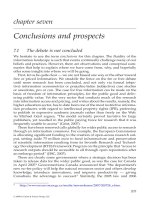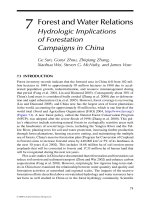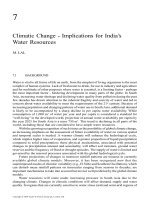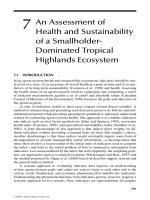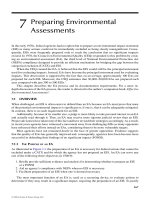Chapter 7 Exercises Aggregate Demand and Aggregate Supply
Bạn đang xem bản rút gọn của tài liệu. Xem và tải ngay bản đầy đủ của tài liệu tại đây (160.84 KB, 7 trang )
Chapter 7 Aggregate Demand and Aggregate Supply
MULTIPLE CHOICE
6.
Business cycles
a. are easily predicted by competent economists.
b. have never occurred very close together.
c. can only be seen as changes in real GDP.
d. None of the above is correct.
ANSWER: d.
None of the above are correct.
TYPE: M DIFFICULTY: 1 SECTION: 20.1
8.
During recessions
a. sales and profits fall.
b. sales and profits rise.
c. sales rise, profits fall.
d. profits fall, sales rise.
ANSWER: a.
sales and profits fall.
TYPE: M DIFFICULTY: 1 SECTION: 20.1
29.
The model of aggregate demand and aggregate supply explains the relationship between
a. the price and quantity of a particular good.
b. unemployment and output.
c. wages and employment.
d. real GDP and the price level.
ANSWER: d.
real GDP and the price level.
TYPE: M DIFFICULTY: 1 SECTION: 20.2
30.
The variables on the vertical and horizontal axes of the aggregate supply and demand curve are
a. the price level, real output.
b. real output, employment.
c. employment, the inflation rate.
d. the value of money, the price level.
ANSWER: a.
the price level, real output.
TYPE: M DIFFICULTY: 1 SECTION: 20.2
31.
Which of the sentences concerning the aggregate demand and aggregate supply model is correct?
a. The aggregate demand and supply model is nothing more than a large version of the model of market demand
and supply.
b. The price level adjusts to bring aggregate demand and supply into balance.
c. The aggregate supply curve shows the quantity of goods and services that households, firms, and the
government want to buy at each price.
d. All of the above are correct.
ANSWER: b.
The price level adjusts to bring aggregate demand and supply into balance.
TYPE: M DIFFICULTY: 1 SECTION: 20.2
32.
Which of the following adjusts to bring aggregate supply and demand into balance?
a. the price level
b. the real rate of interest
c. the money supply
d. technology
ANSWER: a.
the price level
TYPE: M DIFFICULTY: 1 SECTION: 20.2
537
33.
The aggregate demand curve
a. slopes downward for the same reasons that market demand curves slope downward.
b. is vertical in the long run.
c. shows an inverse relation between the price level and the quantity of all goods and services demanded.
d. All of the above are correct.
ANSWER: c.
shows an inverse relation between the price level and the quantity of all goods and services demanded.
TYPE: M DIFFICULTY: 1 SECTION: 20.3
34.
A fall in the economy's overall level of prices tends to
a. raise both the quantity demanded and supplied of goods and services.
b. raise the quantity demanded of goods and services, but lower the quantity supplied.
c. lower the quantity demanded of goods and services, but raise the quantity supplied.
d. lower both the quantity demanded and the quantity supplied of goods and services.
ANSWER: b.
raise the quantity demanded of goods and services, but lower the quantity supplied.
TYPE: M DIFFICULTY: 1 SECTION: 20.3
35.
A rise in the economy's overall level of prices tends to
a. raise both the quantity demanded and supplied of goods and services.
b. raise the quantity demanded of goods and services, but lower the quantity supplied.
c. lower the quantity demanded of goods and services, but raise the quantity supplied.
d. lower both the quantity demanded and the quantity supplied of goods and services.
ANSWER: c.
lower the quantity demanded of goods and services, but raise the quantity supplied.
TYPE: M DIFFICULTY: 1 SECTION: 20.3
36.
Which of the following is included in the aggregate demand for goods and services?
a. consumption demand
b. investment demand
c. net exports
d. All of the above are correct.
ANSWER: d.
All of the above are correct.
TYPE: M DIFFICULTY: 1 SECTION: 20.3
37.
Which of the following is not included in aggregate demand?
a. purchases of stock and bonds
b. purchases of services such as visits to the doctor
c. purchases of capital goods such as equipment in a factory
d. purchases by foreigners of consumer goods produced in the United States
ANSWER: a.
purchases of stock and bonds
TYPE: M DIFFICULTY: 1 SECTION: 20.3
41.
Ceteris paribus, as the price level rises, dollars become
a. more valuable, and interest rates rise.
b. more valuable, and interest rates fall.
c. less valuable, and interest rates rise.
d. less valuable, and interest rates fall.
ANSWER: c.
less valuable, and interest rates rise.
TYPE: M DIFFICULTY: 2 SECTION: 20.3
42.
Ceteris paribus, as the price level falls, dollars become
a. more valuable, and interest rates rise.
b. more valuable, and interest rates fall.
c. less valuable, and interest rates rise.
d. less valuable, and interest rates fall.
ANSWER: b.
more valuable, and interest rates fall.
TYPE: M DIFFICULTY: 2 SECTION: 20.3
43.
Ceteris paribus, as the price level falls, a country’s exchange rate
a. and interest rates rise.
b. and interest rates fall.
c. fall and interest rates rise.
d. rise and interest rates fall.
ANSWER: b.
and interest rates fall.
TYPE: M DIFFICULTY: 2 SECTION: 20.3
44.
Ceteris paribus, as the price level rises, exchange rates
a. and interest rates rise.
b. and interest rates fall.
c. fall and interest rates rise.
d. rise and interest rates fall.
ANSWER: a.
and interest rates rise.
TYPE: M DIFFICULTY: 2 SECTION: 20.3
45.
Ceteris paribus, as the price level rises, the real value of money
a. and the exchange rate rise.
b. and the exchange rate fall.
c. rises and the exchange rate falls.
d. falls and the exchange rate rises.
ANSWER: d.
falls and the exchange rate rises.
TYPE: M DIFFICULTY: 2 SECTION: 20.3
49.
People will spend more if the price level
a. rises, making the dollars they hold worth more.
b. rises, making the dollars they hold worth less.
c. falls, making the dollars they hold worth more.
d. falls, making the dollars they hold worth less.
ANSWER: c.
falls, making the dollars they hold worth more.
TYPE: M DIFFICULTY: 1 SECTION: 20.3
50.
People will spend more if real wealth
a. and interest rates rise.
b. rises and interest rates fall.
c. falls and interest rates rise.
d. and interest rates fall.
ANSWER: b.
rises and interest rates fall.
TYPE: M DIFFICULTY: 1 SECTION: 20.3
54.
The aggregate quantity of goods demanded increases if
a. real wealth falls.
b. the interest rate rises.
c. the dollar depreciates.
d. None of the above is correct.
ANSWER: c.
the dollar depreciates.
TYPE: M DIFFICULTY: 2 SECTION: 20.3
55.
The aggregate quantity of goods demanded increases if
a. real wealth rises.
b. the interest rate rises.
c. the dollar appreciates.
d. All of the above are correct.
ANSWER: a.
real wealth rises.
TYPE: M DIFFICULTY: 1 SECTION: 20.3
56.
The aggregate quantity of goods demanded decreases if
a. real wealth falls.
b. the interest rate rises.
c. the dollar appreciates.
d. All of the above are correct.
ANSWER: d.
All of the above are correct.
62.
Investment spending decreases when the price level
a. rises causing interest rates to rise.
b. rises causing interest rates to fall.
c. falls causing interest rates to rise.
d. falls causing interest rates to fall.
ANSWER: a.
rises causing interest rates to rise.
TYPE: M DIFFICULTY: 2 SECTION: 20.3
63.
A decrease in the price level causes real wealth to
a. fall, people to lend less, interest rates to fall, and the dollar to appreciate.
b. fall, people to lend less, interest rates to rise, and the dollar to depreciate.
c. rise, people to lend more, interest rates to rise, and the dollar to appreciate.
d. rise, people to lend more, interest rates to fall, and the dollar to depreciate.
ANSWER: d.
rise, people to lend more, interest rates to fall, and the dollar to depreciate.
TYPE: M DIFFICULTY: 2 SECTION: 20.3
64.
A decrease in the price level causes the interest rate to
a. increase, the dollar to appreciate, and net exports to increase.
b. increase, the dollar to depreciate, and net exports to decrease.
c. decrease, the dollar to depreciate, and net exports to increase.
d. decrease, the dollar to appreciate, and net exports to decrease.
ANSWER: c.
decrease, the dollar to depreciate, and net exports to increase.
TYPE: M DIFFICULTY: 2 SECTION: 20.3
65.
An increase in the price level causes the interest rate to
a. increase, the dollar to depreciate, and net exports to increase.
b. increase, the dollar to appreciate, and net exports to decrease.
c. decrease, the dollar to depreciate, and net exports to increase.
d. decrease, the dollar to appreciate, and net exports to decrease.
ANSWER: b.
increase, the dollar to appreciate, and net exports to decrease.
TYPE: M DIFFICULTY: 2 SECTION: 20.3
66.
When the dollar depreciates, U.S.
a. exports and imports increase.
b. exports increase, while imports decrease.
c. exports decrease, while imports increase.
d. exports and imports decrease.
ANSWER: b.
exports increase, while imports decrease.
TYPE: M DIFFICULTY: 2 SECTION: 20.3
67.
When the dollar appreciates, U.S.
a. exports decrease, while imports increase.
b. exports and imports decrease.
c. exports and imports increase.
d. exports increase, while imports decrease.
ANSWER: a.
exports decrease, while imports increase.
TYPE: M DIFFICULTY: 2 SECTION: 20.3
98.
The aggregate supply curve is vertical in
a. the short and long run.
b. neither the short nor long run.
c. the long run, but not the short run.
d. the short run, but not the long run.
ANSWER: c.
the long run, but not the short run.
TYPE: M DIFFICULTY: 1 SECTION: 20.3
99.
The aggregate supply curve is upward sloping rather than vertical in
a. the short and long run.
b. neither the short nor long run.
c. the long run, but not the short run.
d. the short run, but not the long run.
ANSWER: d.
the short run, but not the long run.
TYPE: M DIFFICULTY: 1 SECTION: 20.4
Consider the exhibit below for the following eight questions.
135. An increase in the money supply would move the economy from C to
a. B in the short run and the long run.
b. D in the short run and the long run.
c. B in the short run and A in the long run.
d. D in the short run and C in the long run.
ANSWER: c.
B in the short run and A in the long run.
TYPE: M DIFFICULTY: 1 SECTION: 20.5
136. An increase the money supply would move the economy from C to
a. A in the long run.
b. B in the long run.
c. return to C in the long run.
d. D in the long run.
ANSWER: a.
A in the long run.
TYPE: M DIFFICULTY: 2 SECTION: 20.5
137. If the economy is at A and there is a fall in aggregate demand, in the short run the economy
a. stays at A.
b. moves to B.
c. moves to C.
d. moves to D.
ANSWER: d.
moves to D.
TYPE: M DIFFICULTY: 1 SECTION: 20.5
138. If the economy starts at A and there is a fall in aggregate demand, the economy moves
a. back to A in the long run.
b. to B in the long run.
c. to C in the long run.
d. to D in the long run.
ANSWER: c.
to C in the long run.
TYPE: M DIFFICULTY: 1 SECTION: 20.5
139. If the economy starts at A and moves to D, the economy moves
a. to A in the long run.
b. to B in the long run.
c. to C in the long run.
d. back to D in the long run.
ANSWER: c.
to C in the long run.
TYPE: M DIFFICULTY: 1 SECTION: 20.5
140. The economy would be moving to long-run equilibrium if it started at
a. A and moved to B.
b. C and moved to B.
c. D and moved to C.
d. None of the above is correct.
ANSWER: c.
D and moved to C.
TYPE: M DIFFICULTY: 1 SECTION: 20.5
141. An adverse shift in aggregate supply would move the economy from
a. A to B.
b. C to D.
c. B to A
d. D to C
ANSWER: b.
C to D.
TYPE: M DIFFICULTY: 1 SECTION: 20.5
142. In the short run, a favorable shift in aggregate supply would move the economy from
a. A to B.
b. B to C.
c. C to D.
d. D to A.
ANSWER: a.
A to B.
TYPE: M DIFFICULTY: 1 SECTION: 20.5
166. When production costs rise,
a. the short-run aggregate supply curve shifts to the right.
b. the short-run aggregate supply curve shifts to the left.
c. the aggregate demand curve shifts to the right.
d. the aggregate demand curve shifts to the left.
ANSWER: b.
the short-run aggregate supply curve shifts to the left.
TYPE: M DIFFICULTY: 1 SECTION: 20.5
167. When production costs rise, in the short run
a. output and prices rise.
b. output rises and prices fall.
c. output falls and prices rise.
d. output and prices fall.
ANSWER: c.
output falls and prices rise.
TYPE: M DIFFICULTY: 1 SECTION: 20.5
168. Which of the following shift short-run aggregate supply left?
a. an increase in price expectations
b. an increase in the price level
c. a decrease in the money supply
d. a decrease in the price of oil
ANSWER: a.
an increase in price expectations
TYPE: M DIFFICULTY: 2 SECTION: 20.5
TYPE: S DIFFICULTY: 3 SECTION: 20.5




